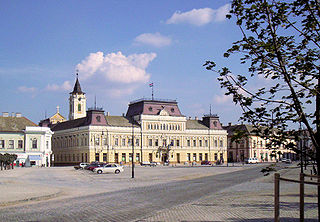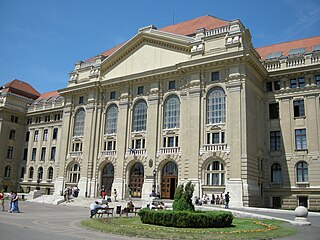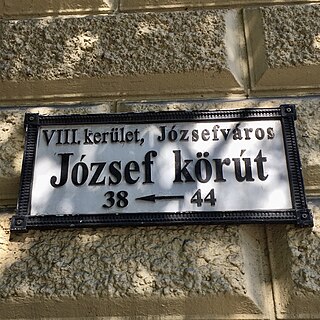
József Mindszenty was a Hungarian cardinal of the Catholic Church who served as Archbishop of Esztergom and leader of the Catholic Church in Hungary from 1945 to 1973. According to the Encyclopedia Britannica, for five decades "he personified uncompromising opposition to fascism and communism in Hungary".

Count István Széchenyi de Sárvár-Felsővidék was a Hungarian politician, political theorist, and writer. Widely considered one of the greatest statesmen in his nation's history, within Hungary he is still known to many as "the Greatest Hungarian".

Baja is a city with county rights in Bács-Kiskun County, southern Hungary. It is the second largest city in the county, after the county seat at Kecskemét, and is home to some 35,000 people. Baja is the seat of the Baja municipality.

The Archdiocese of Esztergom–Budapest is a Latin Church archdiocese and primatial seat of the Roman Catholic Church in Hungary and the metropolitan see of one of Hungary's four Latin Church ecclesiastical provinces.

The National Széchényi Library (OSZK) is a library in Budapest, Hungary, located in Buda Castle. It is one of two Hungarian national libraries, the other being University of Debrecen Library.

Miskolc City Centre is the historical centre of Miskolc, Hungary. Most other areas of the city were independent towns or villages beforehand, or were subsequently built afterwards.

Pázmány Péter Catholic University (PPCU) is a private university in and near Budapest, Hungary, belonging to the Catholic Church and recognized by the state. While PPCU takes its name after an institution founded in 1635, it forms a modern, split-off limb from one of Hungary's oldest and most prestigious institutions of higher education, that has expanded further in the second half of the 20th century.

The University of Debrecen is a university located in Debrecen, Hungary. It is the oldest continuously operating institution of higher education in Hungary ever since its establishment in 1538. The university has a well established programme in the English language for international students, particularly in the Medical and Engineering field, which first established education in English in 1886. There are nearly 6000 international students studying at the university.

Balatonföldvár is a popular resort town in Somogy County, Hungary, on the southern side of Lake Balaton, approximately 120 km southwest from Budapest and about 23 km southwest from Siófok, the "capital of Balaton". Balatonföldvár is a frequently visited tourist destination among Hungarians and foreign guests because of its natural beauties, historical heritages or its countless leisure opportunities. The town offer several water sport and mainland sport activities.

Budapest's Palotanegyed forms an inner part of Pest, the eastern half of Budapest. Known until the communist period as the ‘Magnates’ Quarter’, it consists of the most westerly part of the city's Eighth District, or Józsefváros, which was named on 7 November 1777 after Joseph II, Holy Roman Emperor and Archduke of Austria (1741-1790), who reigned 1765-1790. . Józsefváros developed immediately east of the medieval walls of Pest and was originally called Lerchenfeld or the Alsó-Külváros. The Palotanegyed's borders are the Múzeum körút to the west, Rákóczi út to the north, the József körút to the east and Üllői út to the south. There is an extensive photo archive of the Palace District at the Fortepan website.

The Church of St. Stephen of Hungary is a Roman Catholic church in the Archdiocese of New York, located at 402-412 East 82nd Street, Manhattan, New York City. The former parish of St. Stephen was administered by the Order of Friars Minor from its founding in 1922 until its merger with St. Joseph's in 2015.

József Grősz was a Hungarian politician and prelate of the Roman Catholic Church. From 1943 until his death 18 years later, he served as the Archbishop of Kalocsa. Despite initially being known for his willingness to co-operate with the Communist government of the time, he was put on trial in 1951. Sentenced to 15 years imprisonment, he was released in March 1956 during the period of de-Stalinization.
Dénes Farkas de Boldogfa Hungarian nobleman, landowner, politician, member of the Hungarian Parliament.

József Halzl was a mechanical engineer, co-founder of the Hungarian Democratic Forum and Honorary Life Chairman of the Rákóczi Association.

Count Sigmund Széchenyi of Sárvár-Felsővidék was a Hungarian hunter, traveler and writer. He was a main figure of the Hungarian hunting culture, having hunted in Africa, India, Alaska and various parts of Europe. His outstanding hunting trophy is a world record addax, and his hunting library is the most significant collection of hunting books in Hungary, which can currently be viewed in the Hungarian Museum of Natural History.

The Faculty of Humanities is the oldest faculty of Eötvös Loránd University in Józsefváros, Budapest, Hungary. It was founded by the Cardinal Archbishop of Esztergom Prince Primate of Hungary, Péter Pázmány, in 1635.















